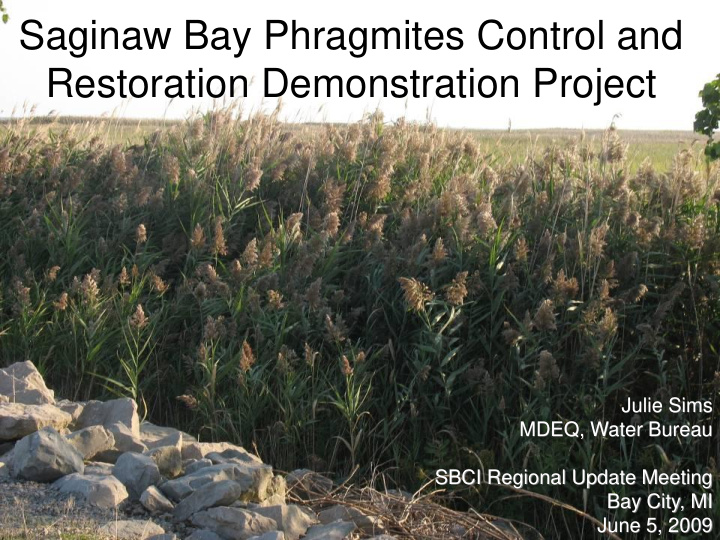



Saginaw Bay Phragmites Control and Restoration Demonstration Project Julie Sims MDEQ, Water Bureau SBCI Regional Update Meeting Bay City, MI June 5, 2009
Presentation Overview • Background on Invasive Phragmites • Update on Demonstration Project • Results and Findings • Next Steps
Understanding Phragmites • The aggressive non native variety of Phragmites, or common reed, is a wetland plant that is present in nearly all U.S. states • Phragmites is a perennial, warm season grass that can grow in dense stands, reach heights of 15 + feet and is long living. • Phragmites is capable of reproduction by seeds, but primarily does so asexually by rhizomes.
The Problem • Threatens coastal and interior wetlands, which are Michigan’s most biologically diverse and productive ecosystems • Displaces desirable native plant species • Reduction of wildlife habitat diversity • Restriction of shoreline views • Creation of potentially serious fire hazard
Successful Phragmites Control • Understand phragmites life cycle • Become familiar with herbicide types and application methods • Determine best sequence for secondary treatments – Mechanical – Burning – Flooding – Repeated herbicide treatments • Follow up with additional herbicide treatments as necessary
SBCI Demonstration Project • Partners – DEQ’s Land and Water Management Division, Office of the Great Lakes, and Water Bureau – DNR – Ducks Unlimited • Funding – EPA Great Lakes National Program Office – National Fish and Wildlife Foundation – BASF – Cygnet Enterprises
Saginaw Bay Demonstration Project This project will attempt to eliminate or significantly reduce Phragmites in coastal shoreline locations to demonstrate to landowners: effectiveness of the chemical treatment option of mowing benefit of treating early benefits of controlling invasive phragmites in coastal wetlands
Phragmites Management • Step 1: Chemical control - systemic herbicides, timing, dosage, techniques • Step 2: Follow-up chemical treatment, mechanical, prescribed burning, flooding • Step 3: Monitor, repeat! (long-term commitment)
What Have We Been Up To? • Phragmites stakeholder workgroup • Develop information materials • Implement treatment at the demonstration project site • Evaluate control activities • Media event
Available Resources to Assist Property Owners & Resource Managers www.michigan.gov/deqaquaticinvasives
Interpretive Signage
Treatment Methods
Treatment Methods
Treatment Methods
Treatment Plots
Mowing plot Photo monitoring Sept 2007 Photo monitoring Sept 2008 Vegetation monitoring- August 2008
Glyphosate Plot Photo monitoring Sept 2007 Photo monitoring Sept 2008 Vegetation monitoring- August 2008
Combo Plot Photo monitoring Sept 2008 Photo monitoring Sept 2008 Vegetation monitoring- August 2008
Imazapyr Plot Photo monitoring Sept 2008 Photo monitoring Sept 2007 Vegetation monitoring- August 2008
Control Plot Photo monitoring Sept 2007 Photo monitoring Sept 2008 Vegetation monitoring- August 2008
Questions and Comments Julie Sims Michigan Department of Environmental Quality simsj@michigan.gov (517) 373-2732
Recommend
More recommend